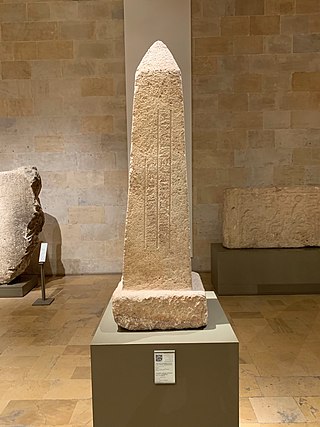Top Qs
Timeline
Chat
Perspective
Abishemu obelisk
Ancient Egyptian obelisk From Wikipedia, the free encyclopedia
Remove ads
The Abishemu obelisk or the Abichemou obelisk is a 1.25 meter limestone obelisk dedicated to the Phoenician king Abishemu I of Byblos. The obelisk is decorated with two lines of inscriptions in Egyptian hieroglyphics. It was created c. 1800 BCE, and was unearthed in the 1950s by Maurice Dunand in the Temple of the Obelisks. It is the world's third-oldest obelisk, and by far the oldest obelisk found outside Egypt.
Although only approximately a dozen words long, the obelisk contains:
- the name of one of the oldest known kings of Byblos, Abishemu I
- the earliest reference to the Lukka people, known from numerous later Egyptian and Hittite sources[1][2]
- a reference to "Herishef", considered by Dunand to be the Egyptian name of the Canaanite god Resheph, and thus giving the alternate name "Temple of Resheph" for the Temple of the Obelisks[3]
The obelisk is the only example of a complete obelisk with a true pyramidion found in the Temple of the Obelisks; most of the others were rough steles.[4] It consists of a square plinth at the bottom, a tapering shaft and with a pyramidion at the top.[4]
Remove ads
Inscription

Transcribed:[4]
mry Ḥr-š·f ḥꜣty-ʻ n Kpny ʼb-šmw wḥm ʻnḫ
[...]f Kwkwn śꜣ Rwqq mꜣʻ ḫrw
Translated:[4]
Beloved of Arsaphes [also translated Herishef], Abishemu, prince of Byblos, renewed in life, his
..., Kukun, son of 'the Lycian' justified (i. e., deceased).
See also
Notes
References
Wikiwand - on
Seamless Wikipedia browsing. On steroids.
Remove ads

